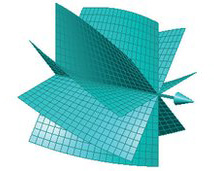2.56 terabits / c in "twisted" waves
 In the journal Nature Photonics published a scientific article of a group of American and Israeli researchers who conducted an experiment on the transfer of data at a speed of 2.56 terabits / s in beams of light through free space.
In the journal Nature Photonics published a scientific article of a group of American and Israeli researchers who conducted an experiment on the transfer of data at a speed of 2.56 terabits / s in beams of light through free space.This experiment proved the super-efficiency of a new method of modulating a signal based on the effect of the orbital angular momentum of a light wave (OAM), that is, "swirling" waves . In the 1990s, scientists began using OAM in various fields, from optical experiments to quantum information processing. In the early 2000s, “twisted” waves were first tested for data transmission .
The aforementioned group of scientists was able to apply modulation and multiplexing of waves, so it turned out to combine several twisted waves with a different value of orbital angular momentum in one beam. Moreover, they proved the scalability of the system in space, that is, the ability to transmit several beams simultaneously.

')
During the experiment, the transmission of light waves in two groups, each of eight beams, was carried out, in each beam multiplexing with polarization and 16-QAM modulation for “twisted” waves with different orbital angular momentum were used. This system showed a data transfer rate of 2.56 terabits / s and spectral efficiency of 95.7 bps / Hz.
According to scientists, this experiment demonstrates the suitability of OAM technology for use in commercial wireless data transmission systems. According to engineers , OAM can be used to compact (multiplex) radio waves at almost any frequency.
For comparison, in LTE spectral efficiency is 16.32 bps / Hz, in 802.11n - 2.4 bps / Hz, in DVB-T - only 0.55 bps / Hz.
Source: https://habr.com/ru/post/146615/
All Articles